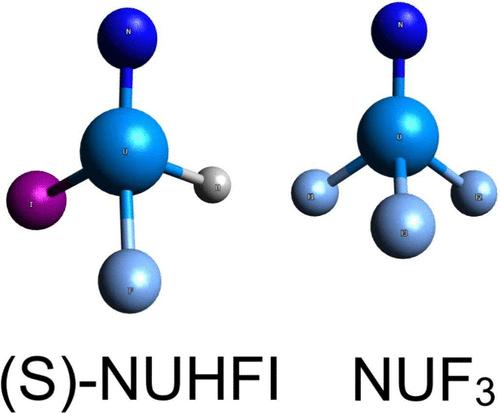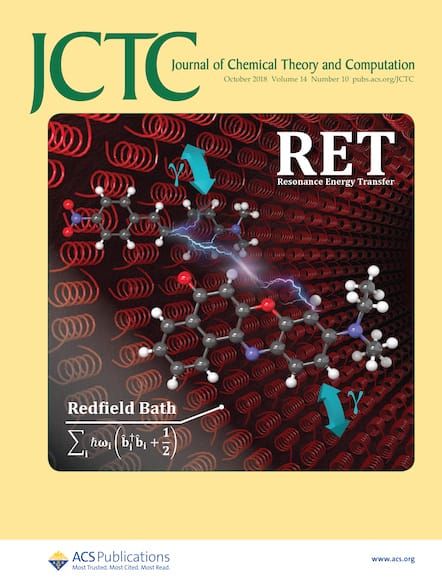4c 相对域中的 DMRG 定制耦合簇方法:NUHFI 和 NUF3 分子的一般实现和应用
IF 5.5
1区 化学
Q2 CHEMISTRY, PHYSICAL
引用次数: 0
摘要
由于需要同时处理相对论效应和相关效应,重原子核化合物是计算化学面临的一项挑战。通常情况下,此类系统还表现出很强的相关性,这阻碍了扰动理论或单参量耦合簇(CC)方法的应用。作为一种可行的替代方法,我们建议使用密度矩阵重正化群(DMRG)波函数对 CC 方法进行外部修正,从而得到 DMRG 修正 CC 方法。在之前的一篇论文[J. Chem. Phys. 2020, 152, 174107]中,我们报告了该方法在相对论背景下的首次实现,但仅限于具有实双群对称性的分子。在这项工作中,我们提出了该方法的完全通用实施方案,同时涵盖了复双群和四元双群。因此,4c-TCC 方法适用于多原子分子,包括重金属原子。为了评估该方法,我们对手性铀化合物 NUHFI 进行了计算。特别是,我们计算了该分子沿 N-U 键伸展方向的势能面切面,该系统在该切面上表现出很强的多参考特性。由于没有 NUHFI 的实验数据,我们还对 NUF3 分子(对称性更强)进行了类似研究,将 N-U 键的振动频率与光谱数据进行了比较。本文章由计算机程序翻译,如有差异,请以英文原文为准。

DMRG-Tailored Coupled Cluster Method in the 4c-Relativistic Domain: General Implementation and Application to the NUHFI and NUF3 Molecules
Heavy atom compounds represent a challenge for computational chemistry due to the need for simultaneous treatment of relativistic and correlation effects. Often such systems also exhibit strong correlation, which hampers the application of perturbation theory or single-reference coupled cluster (CC) methods. As a viable alternative, we have proposed externally correcting the CC method using the density matrix renormalization group (DMRG) wave functions, yielding the DMRG-tailored CC method. In a previous paper [J. Chem. Phys. 2020, 152, 174107], we reported a first implementation of this method in the relativistic context, which was restricted to molecules with real double group symmetry. In this work, we present a fully general implementation of the method, covering complex and quaternion double groups as well. The 4c-TCC method thus becomes applicable to polyatomic molecules, including heavy atoms. For the assessment of the method, we performed calculations of the chiral uranium compound NUHFI, which was previously studied in the context of the enhancement of parity violation effects. In particular, we performed calculations of a cut of the potential energy surface of this molecule along the stretching of the N–U bond, where the system exhibits strong multireference character. Since there are no experimental data for NUHFI, we have performed also an analogous study of the (more symmetric) NUF3 molecule, where the vibrational frequency of the N–U bond can be compared with spectroscopic data.
求助全文
通过发布文献求助,成功后即可免费获取论文全文。
去求助
来源期刊

Journal of Chemical Theory and Computation
化学-物理:原子、分子和化学物理
CiteScore
9.90
自引率
16.40%
发文量
568
审稿时长
1 months
期刊介绍:
The Journal of Chemical Theory and Computation invites new and original contributions with the understanding that, if accepted, they will not be published elsewhere. Papers reporting new theories, methodology, and/or important applications in quantum electronic structure, molecular dynamics, and statistical mechanics are appropriate for submission to this Journal. Specific topics include advances in or applications of ab initio quantum mechanics, density functional theory, design and properties of new materials, surface science, Monte Carlo simulations, solvation models, QM/MM calculations, biomolecular structure prediction, and molecular dynamics in the broadest sense including gas-phase dynamics, ab initio dynamics, biomolecular dynamics, and protein folding. The Journal does not consider papers that are straightforward applications of known methods including DFT and molecular dynamics. The Journal favors submissions that include advances in theory or methodology with applications to compelling problems.
 求助内容:
求助内容: 应助结果提醒方式:
应助结果提醒方式:


